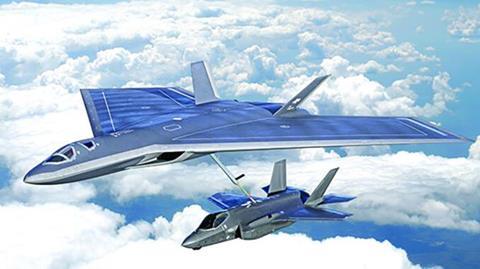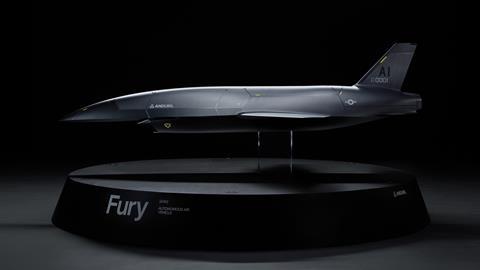The US Air Force (USAF) plans in the coming months to announce major changes to some of its most-significant aircraft-modernisation programmes.
Development programmes under review include the sixth-generation Next Generation Air Dominance (NGAD) platform, the Next-Generation Air-refuelling System (NGAS) and the next tranche of low-cost, autonomous fighter jets known as Collaborative Combat Aircraft (CCA).
“Our intent is to have simultaneous and well-supported answers about the design concepts for NGAD, NGAS and CCA,” USAF secretary Frank Kendall said on 16 September during the Air & Space Forces Association (AFA) annual event near Washington DC. “Standby for answers over the next few months.”
Not far from where Kendall spoke, the two contractors selected for the first increment of CCAs – General Atomics Aeronautical Systems and Anduril – displayed scale models of their autonomous fighter designs for the first time.
Flight-capable versions of the two aircraft will soon take to the skies for testing, Kendall says. “At least one of them will be in our inventory in meaningful numbers in the next few years.”

The USAF says the CAA programme will provide “affordable mass” to counter numerical advantages in ships and long-range precision missiles enjoyed by China in the Western Pacific.
CCAs may occasionally operate alone in hazardous environments. But the USAF still views their primary mission as supporting fighters, including current models like the Lockheed Martin F-35 and Boeing F-15EX, and the follow-on NGAD air superiority aircraft.
The NGAD was conceived before the USAF’s pivot toward low-cost autonomy, and Kendall describes the original vision as “essentially an F-22 replacement”, referencing the iconic Lockheed air superiority stealth fighter operated only by the USAF.
The Pentagon changed tack primarily due to concern about NGAD’s affordability – both development costs and per-aircraft prices.
“We need a unit cost that is affordable in significant quantities,” Kendall says.

Under a 2023 industry solicitation, the USAF hoped to select an NGAD contractor by end-2024. After Northrop Grumman bowed out of that project, Boeing and Lockheed were believed to be the remaining finalists.
Boeing went so far as to commit nearly $2 billion to start building a new factory geared toward producing advanced combat aircraft.
The current NGAD design proposals, which Kendall describes as “fairly mature”, would have unit costs equivalent to multiple F-35s.
But the service wants to get the price down. It pays around $80 million for the conventional take-off and landing F-35A under the most-recent production contracts. Kendall says that price represents an attractive target for a future crewed fighter platform.
To support its NGAD capability, the USAF also needs a refuelling jet capable of operating in contested environments.
“The threat is now reaching out to longer and longer ranges,” Kendall says. “That puts both tanker and transport aircraft at risk. This is a particular problem for aerial refuelling of fighters within their combat radius ranges.”
The USAF’s solution is the NGAS tanker, about which little is known. Kendall previously said NGAS is to be the USAF’s first non-commercial derivative refueller, with the possibility of a stealthy or low-observable design.
“We’ve gone through an evolution in our strategy to recapitalise the tanker fleet,” the secretary adds.
That evolution involved a two-year, formal analysis of alternative NGAS capability requirements, which Kendall says will be completed soon. USAF assistant secretary Andrew Hunter, who oversees acquisition, says the analysis will help the service set capabilities for NGAS procurement.

The USAF took a step toward developing the new tanker earlier this month when it issued a request for information (RFI) to industry suppliers related to unspecified mission systems for NGAS – systems Kendall says would also support operations of the future tanker.
With the RFI, the USAF aims to ensure the defence industry is involved in development as early as possible, Hunter says, adding that the service expects also to issue a separate RFI related to the actual NGAS airframe.
One new aircraft programme that appears to be proceeding as planned is the USAF’s next-generation stealth bomber – the Northrop Grumman B-21 Raider.
Kendall cautions against expressing too much optimism about new development programmes, but says the B-21’s “progress to date is encouraging”.
The USAF incorporated strict price targets into its B-21 contract with Northrop to prevent the cost creep that nearly proved fatal to the Raider’s predecessor – Northrop’s B-2 Spirit flying wing. That programme’s massive per-unit cost of nearly $2 billion (in inflation-adjusted dollars) resulted in the USAF procuring just 20 of the stealthy bombers – at least one of which has since been retired.
The USAF says it is committed to fielding at least 100 B-21s, which Kendall describes as an “essential contributor” to the USA’s strategic nuclear deterrent.































